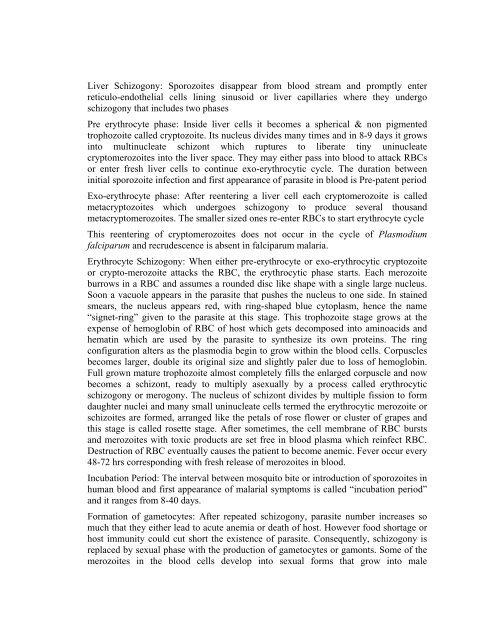ANIMAL DIVERSITY – I (NON-CHORDATES)
ANIMAL DIVERSITY – I (NON-CHORDATES)
ANIMAL DIVERSITY – I (NON-CHORDATES)
Create successful ePaper yourself
Turn your PDF publications into a flip-book with our unique Google optimized e-Paper software.
Liver Schizogony: Sporozoites disappear from blood stream and promptly enter<br />
reticulo-endothelial cells lining sinusoid or liver capillaries where they undergo<br />
schizogony that includes two phases<br />
Pre erythrocyte phase: Inside liver cells it becomes a spherical & non pigmented<br />
trophozoite called cryptozoite. Its nucleus divides many times and in 8-9 days it grows<br />
into multinucleate schizont which ruptures to liberate tiny uninucleate<br />
cryptomerozoites into the liver space. They may either pass into blood to attack RBCs<br />
or enter fresh liver cells to continue exo-erythrocytic cycle. The duration between<br />
initial sporozoite infection and first appearance of parasite in blood is Pre-patent period<br />
Exo-erythrocyte phase: After reentering a liver cell each cryptomerozoite is called<br />
metacryptozoites which undergoes schizogony to produce several thousand<br />
metacryptomerozoites. The smaller sized ones re-enter RBCs to start erythrocyte cycle<br />
This reentering of cryptomerozoites does not occur in the cycle of Plasmodium<br />
falciparum and recrudescence is absent in falciparum malaria.<br />
Erythrocyte Schizogony: When either pre-erythrocyte or exo-erythrocytic cryptozoite<br />
or crypto-merozoite attacks the RBC, the erythrocytic phase starts. Each merozoite<br />
burrows in a RBC and assumes a rounded disc like shape with a single large nucleus.<br />
Soon a vacuole appears in the parasite that pushes the nucleus to one side. In stained<br />
smears, the nucleus appears red, with ring-shaped blue cytoplasm, hence the name<br />
“signet-ring” given to the parasite at this stage. This trophozoite stage grows at the<br />
expense of hemoglobin of RBC of host which gets decomposed into aminoacids and<br />
hematin which are used by the parasite to synthesize its own proteins. The ring<br />
configuration alters as the plasmodia begin to grow within the blood cells. Corpuscles<br />
becomes larger, double its original size and slightly paler due to loss of hemoglobin.<br />
Full grown mature trophozoite almost completely fills the enlarged corpuscle and now<br />
becomes a schizont, ready to multiply asexually by a process called erythrocytic<br />
schizogony or merogony. The nucleus of schizont divides by multiple fission to form<br />
daughter nuclei and many small uninucleate cells termed the erythrocytic merozoite or<br />
schizoites are formed, arranged like the petals of rose flower or cluster of grapes and<br />
this stage is called rosette stage. After sometimes, the cell membrane of RBC bursts<br />
and merozoites with toxic products are set free in blood plasma which reinfect RBC.<br />
Destruction of RBC eventually causes the patient to become anemic. Fever occur every<br />
48-72 hrs corresponding with fresh release of merozoites in blood.<br />
Incubation Period: The interval between mosquito bite or introduction of sporozoites in<br />
human blood and first appearance of malarial symptoms is called “incubation period”<br />
and it ranges from 8-40 days.<br />
Formation of gametocytes: After repeated schizogony, parasite number increases so<br />
much that they either lead to acute anemia or death of host. However food shortage or<br />
host immunity could cut short the existence of parasite. Consequently, schizogony is<br />
replaced by sexual phase with the production of gametocytes or gamonts. Some of the<br />
merozoites in the blood cells develop into sexual forms that grow into male
















